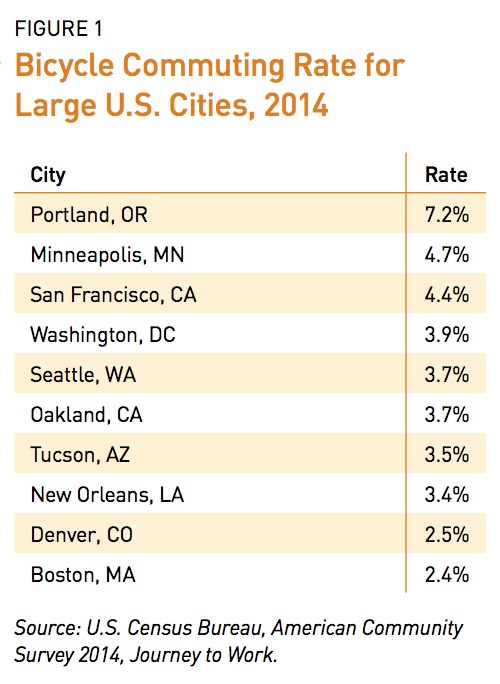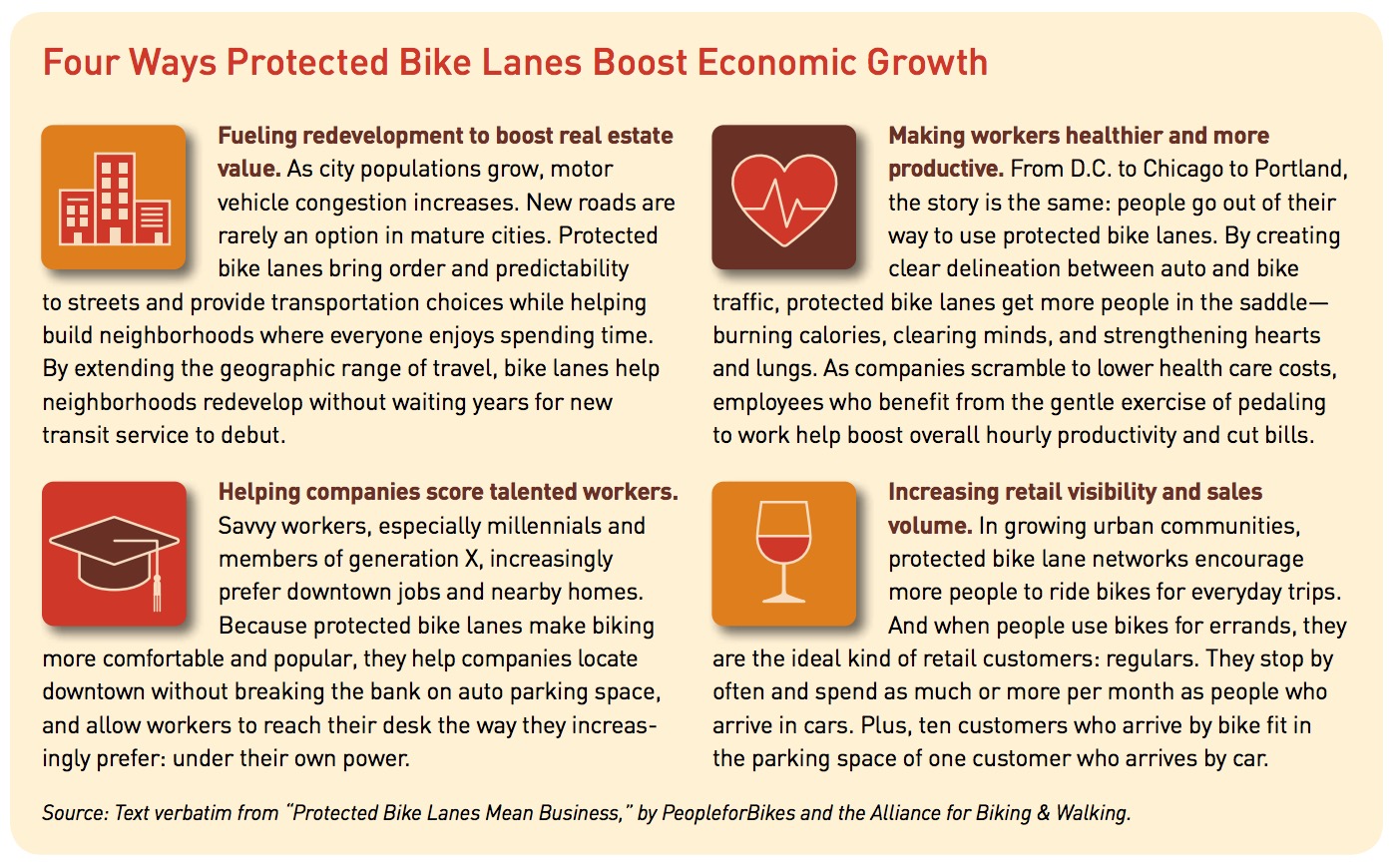URBAN LAND INSTITUTE
Chapter 1: Trends in Active Transportation
Active transportation was, until recently, the forgotten mode of travel. However, in recent years, investments in infrastructure that accommodates those who walk and ride bicycles have begun to reshape communities. Sometimes called “nonmotorized transportation,” active transportation involves human-powered activity, primarily walking and bicycling.
Walking, of course, is as old as humankind, but in places around the world, including the United States—a country that over the past several decades has been designed around motor vehicles— walking and bicycling came to be considered the domain of children, the elderly, or people without the financial means to own a car. Today, however, walkable and bike-friendly communities are growing in popularity.
Fifty percent of U.S. residents say that walkability is a top priority or a high priority when considering where to live, according to the Urban Land Institute’s America in 2015 report, and, according to the U.S. Census, bicycling has become the country’s fastest-growing form of transportation for commuters.
Bicycling is also still growing in popularity in places that started making the shift to bicycle transportation over the last half-century. The city of Amsterdam, for instance, reports that even though it has long been known as one of the most bike-friendly cities in the world, the number of local bicycle trips has increased by more than 40 percent since the 1990s.
Other world capitals, such as Singapore, currently have comparatively low bicycling rates, but are investing in infrastructure to promote cycling as a healthy, environmentally friendly commuting option. In 2011, only 1 percent of all trips in Singapore were by bicycle, but the government aims to significantly increase this figure by creating safer and more convenient bike routes.
Communities big and small are now investing in bicycle and pedestrian infrastructure. These trends are reshaping destinations across the globe, and have the potential to benefit people of all income brackets, since biking provides mobility for those needing or wanting a less expensive alternative to automobile ownership, maintenance, and use. This report examines the implications of the growing interest in active transportation on economic development, public health, air quality, community design, and real estate investment.
Research shows that the built environment (including buildings, streets, and neighborhoods) has a profound impact on health outcomes. An American Journal of Preventative Medicine study found that people who live in neighborhoods with shops and retail establishments within walking distance have a 35 percent lower risk of obesity.
Bicycling can also reduce energy consumption and greenhouse gas emissions. The European Cyclists Federation found that, if levels of cycling in the European Union were equivalent to those found in Denmark, where the average person cycles almost 600 miles (965 km) each year, bicycle use alone would achieve 26 percent of the 2050 greenhouse gas reduction targets set for the transportation sector
Through supporting bike infrastructure, real estate professionals who influence the built environment can play a significant role in creating healthier, more sustainable communities. They can also help position their projects and communities in a marketplace that increasingly values active transportation.
Bicycling Is Booming
Bicycling has recently undergone a renaissance in locations across the world, with an increasing number of people taking to the streets by bike. In the United States, the U.S. Census showed that the number of people who traveled to work by bike increased roughly 62 percent between 2000 and 2014, while Transport for London found that, in 2014, cycling in London reached its highest rate since record keeping began.
Economic considerations, such as the high cost of owning, operating, and insuring a car—which averaged nearly $8,700 in the United States in 2015, according to AAA—as well as environmental, social, and health factors, have caused a boom in the cycling economy, with indications that this will be a long-term trend.
Who is biking and why? The answer is all kinds of people, on all kinds of bikes, for all kinds of reasons. Today, one sees kids biking to soccer practice, men and women in business attire headed to work, people making short trips to the grocery store or to visit friends, college students going to class, senior citizens out for exercise, and tour groups on bicycle vacations.
It is generally only when cities invest in bicycle infrastructure that residents and visitors begin to use bicycles at rates that exceed the national average. Consider Portland, Oregon, for example: In the 1980s and early 1990s, Portland was a city pretty much like any other in terms of transportation behavior. As of 2014, more than 7 percent of residents commuted to work by bicycle, compared with the national average of less than 1 percent (see figure 1).
Bicycle use in Portland has grown exponentially while other modes have grown relatively modestly or declined. According to the City of Portland Bureau of Transportation, bicycle commuting since 1990 has grown by 400 percent, while transit has grown by just 18 percent and driving has declined by 4 percent.
Steve Towsen, Portland’s city engineer, attributes the bicycling boom to investment in bicycle infrastructure, saying, “Bicycling infrastructure is relatively easy to implement and low-cost compared to other modes.”
The city of Portland estimated the cost of its 300-mile (483 km) network of bike trails, bike lanes, and bike boulevards at approximately $60 million in 2008, which is about the same cost as one mile (1.6 km) of four-lane urban freeway.
Another city where bicycling has boomed is Minneapolis. According to the U.S. Census, almost 5 percent of Minneapolis residents biked to work in 2014, and bike commuting grew by more than 186 percent between 1990 and 2014.
 Even in winter, approximately one-third of regular commuters bike to work at least some of the time, according to Bike Walk Twin Cities. As of 2015, Minneapolis had 129 miles (208 km) of on-street bikeways and 97 miles (156 km) of off-street bikeways, with plans to keep growing the network. “Biking is a huge part of who we are,” explains R.T. Ryback, former mayor of Minneapolis.
Even in winter, approximately one-third of regular commuters bike to work at least some of the time, according to Bike Walk Twin Cities. As of 2015, Minneapolis had 129 miles (208 km) of on-street bikeways and 97 miles (156 km) of off-street bikeways, with plans to keep growing the network. “Biking is a huge part of who we are,” explains R.T. Ryback, former mayor of Minneapolis.
Minneapolis has a long-term goal of 15 percent of citywide transportation being by bicycle by 2025. This is certainly possible if one considers that several large European cities—such as Copenhagen and Amsterdam—have bicycle commuting rates exceeding 40 percent, according to Copenhagenize, an international bike and pedestrian consultant firm. According to the U.S. Department of Transportation’s 2009 National Household Travel Survey, half of all trips taken by people in the United States are under three miles (equivalent to a 20-minute bike ride). This shows that Minneapolis’s goal could be achieved with continuing investments in bicycling infrastructure. Bicycle commuting rates are also growing in the largest U.S. cities (places with populations exceeding 1 million). The U.S. Census showed that Philadelphia had the highest bicycle commuting rate in 2014, at 1.9 percent, followed by Chicago at 1.7 percent. Philadelphia’s bike commuting rate grew nearly 237 percent between 1990 and 2014, and the rate in Chicago grew at a whopping 506 percent during the same period.
Download full version (PDF): Active Transportation and Real Estate
About the Urban Land Institute
uli.org
The Urban Land Institute is a nonprofit research and education organization whose mission is to provide leadership in the responsible use of land and in creating and sustaining thriving communities worldwide. Established in 1936, the Institute today has more than 37,000 members and associates from 82 countries, representing the entire spectrum of the land use and development disciplines. ULI relies heavily on the experience of its members. It is through member involvement and information resources that ULI has been able to set standards of excellence in development practice. The Institute is recognized internationally as one of America’s most respected and widely quoted sources of objective information on urban planning, growth, and development.
Tags: Active Transportation, Bicycling, Cycling, Pedestrian, ULI, Urban land Institute







 RSS Feed
RSS Feed